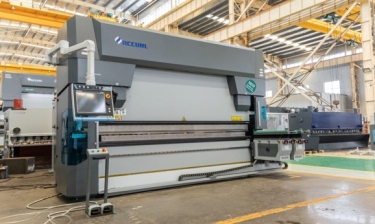What Is a CNC Press Brake?
CNC press brakes are computer-controlled machines used for bending sheet metal into precise shapes. Unlike traditional mechanical press brakes, CNC variants leverage automation to enhance precision and repeatability. This evolution in press brake technology has allowed manufacturers to achieve higher efficiency, reduced labor costs, and greater consistency in metal fabrication processes.
How Does a CNC Press Brake Work?
CNC press brakes function through a combination of programmable software, hydraulic or electric power, and precision tooling. The key operational stages include:
- Material Positioning – The metal sheet is placed on the machine's backgauge, ensuring proper alignment.
- Program Input – Operators input bending angles, material thickness, and other parameters into the CNC controller.
- Clamping and Bending – The punch and die apply force to bend the sheet metal at programmed angles.
- Springback Compensation – Adjustments are made to counteract material elasticity, ensuring accuracy.
- Quality Inspection – The final product is measured to confirm adherence to specified tolerances.
The integration of computer numerical control ensures consistency, reduces human error, and enables complex geometries with ease.
What Are the Different Types of CNC Press Brakes?

Various CNC press brakes cater to different applications, each offering distinct advantages and limitations.
Hydraulic CNC Press Brakes
Hydraulic press brakes use fluid pressure to generate force, making them ideal for high-tonnage applications.
- Strengths: High bending force, durable for heavy-duty operations.
- Limitations: Higher maintenance needs, increased energy consumption.
Electric CNC Press Brakes
Electric press brakes utilize servo motors, providing precise and energy-efficient operation.
- Strengths: Faster cycle times, energy savings, minimal maintenance.
- Limitations: Lower tonnage compared to hydraulic counterparts.
Hybrid CNC Press Brakes
These machines combine hydraulic power with electric efficiency for optimized performance.
- Best Use Case: High-precision applications requiring both power and energy efficiency.
What Are the Main Parts of a CNC Press Brake?
The key components of a CNC press brake include:
- Frame – The structural foundation that houses all components.
- Ram – The moving part that applies force to bend metal.
- Punch and Die – The forming tools that shape the metal sheet.
- Backgauge – Ensures precise material positioning.
- CNC Controller – The software-driven interface that automates the process.
- Hydraulic or Electric Drive System – Powers the machine for efficient operation.
What Are the Key Parameters in CNC Press Brake Operation?
Critical factors influencing performance include:
- Bend Angle – The degree of deformation applied to the metal sheet.
- Tonnage Capacity – The force exerted by the press brake.
- Bending Length – Maximum material width the machine can handle.
- Backgauge Positioning – Ensures repeatable accuracy.
What Are Bending Tolerances for CNC Press Brakes?
Standard bending tolerances typically range from ±0.5mm (±0.02 inches) for precision applications.
What Is the Maximum Thickness a CNC Press Brake Can Bend?
- Mild Steel: Up to 25mm (1 inch)
- Stainless Steel: Up to 16mm (0.63 inches)
- Aluminum: Up to 30mm (1.18 inches)
What Are the Different Bending Methods Used in CNC Press Brakes?
- Air Bending – Uses partial contact between the punch and metal sheet.
- Bottom Bending – The metal fully contacts the die, ensuring precise angles.
- Coining – Applies extreme pressure for exact bend angles with minimal springback.
What Metals Can Be Bent Using a CNC Press Brake?

CNC press brakes accommodate various metals, including:
Mild Steel (Carbon Steel)
- Properties: High strength, easy to weld, cost-effective.
Stainless Steel
- Properties: Corrosion-resistant, durable, difficult to bend.
Aluminum
- Properties: Lightweight, good corrosion resistance, higher springback.
Brass
- Properties: Malleable, aesthetically appealing, medium strength.
Copper
- Properties: Excellent conductivity, soft and flexible.
Galvanized Steel
- Properties: Corrosion-resistant, widely used in construction.
Titanium
- Properties: High strength-to-weight ratio, difficult to bend.
Nickel Alloys
- Properties: Heat-resistant, excellent mechanical properties.
What Is the Best Metal for CNC Press Brake Bending?
The choice depends on factors like bendability, material strength, and application-specific requirements.
What Are the Advantages of Using CNC Press Brakes?
- High precision and repeatability
- Faster production speeds
- Lower material wastage
- Reduced labor costs
- Compatibility with automation
- Versatility in bending complex shapes
What Industries Rely on CNC Press Brakes for Sheet Metal Fabrication?
- Automotive: Chassis components, brackets, and frames.
- Aerospace: Precision bending for aircraft parts.
- Construction: Structural and decorative metal fabrication.
- Medical: Custom parts for medical devices.
- Electronics: Enclosures and metal casings.
What Are the Best CNC Press Brake Machines?
Key selection criteria:
- Accuracy and precision capabilities
- Tonnage capacity
- CNC control system features
- Energy efficiency
What Are Alternative Technologies for Sheet Metal Bending?
- Roll Bending – Ideal for cylindrical shapes.
- Manual Press Braking – Suitable for small-scale operations.
- Stamping – Efficient for high-volume production.
- Hydroforming – Used for complex geometries.
Conclusion
CNC press brakes have revolutionized sheet metal fabrication, offering unmatched precision, efficiency, and cost savings. As industries push for greater automation, these machines remain a cornerstone of modern manufacturing. Their ability to integrate with smart factory systems and adapt to evolving production demands ensures their continued relevance in the future of industrial fabrication.










































